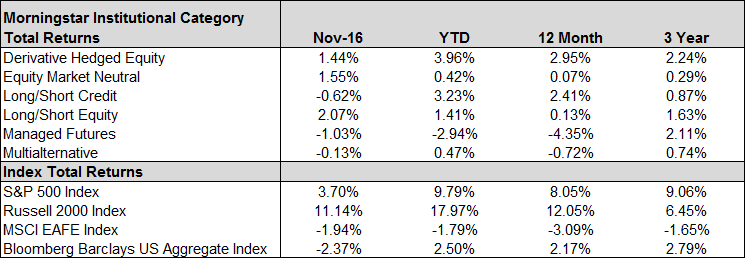There is a tendency in our industry to look at alternative investments as separate and distinct from traditional strategies. But at the most basic level, both alternative and traditional strategies invest in the same assets: equities, bonds, commodities and currencies. Delving a bit deeper, we find that all strategies invest in factors (knowingly or not). Factors are the basic building blocks of return streams. Whether you attribute the payoff to various factors to risk, or to market inefficiencies, value, size, momentum, quality, volatility and carry, among others, they explain a great deal about investment returns.
The failure to understand the factor exposures in a portfolio can quite easily lead to unwarranted disappointment. Take the performance of Long/Short Equity funds in 2015, for example. Many of the worst performing funds in the category were those that employed a value-based strategy. In fact, sorting funds based on Morningstar’s Value-Growth Score, value funds were down 7.3% on average in 2015, while growth funds gained 2.5%.
Value, as a factor, experienced a difficult period in 2015, and as a result, viewing the long/short category monolithically could easily lead you to believe that those funds did a poor job. But many of those same funds rebounded nicely in 2016, in part due to the resurgence of the value factor. According to The Leuthold Group, through November, “…Value has been the only factor that has provided positive performance.”
Their work shows that the value spread – quintile 1 less quintile 5 – for the 3000 largest companies in the U.S., has been about +13% year-to-date, while Momentum, Size, Growth, Volatility, Sentiment and Profitability have all posted negative return spreads.
On the heels of a troubled 2015, investors in those value funds withdrew close to $300 million during the first six months of this year, just before the value factor started to swing into favor. And through November, those value funds were up about 10.7%, while growth funds were off slightly, with an average return of -0.8%. Short-term underperformance = outflows = missed opportunities when performance reverts. A typical pattern that seems to repeat endlessly.
While these observations may not be all that eye opening, they do serve as a reminder that the way in which alternative mutual funds are viewed is years behind traditional, long-only fare. Morningstar, Lipper and others provide investors with short cuts to understanding performance through the way they classify funds. Size and valuation are the primary factors on which long-only funds are sliced and diced, and while there are many more factors to consider, that basic classification goes a long way toward explaining performance.
Alternative mutual funds are thus far not grouped in the same way. The basic categories in use give the appearance that, for example, Long/Short Equity funds are somewhat homogeneous, when nothing could be farther from the truth. Utilizing both holdings-based and returns-based analyses, in addition to interviewing the manager, as part of a thorough diligence process, can triangulate the factor exposures in a portfolio, which will go a long way to setting appropriate expectations and reducing unnecessary manager turnover.

November performance was mixed, as equity-focused strategies were up, while Managed Futures and Long/Short Credit funds produced negative returns. The post-election reaction was quite extreme, seeing many asset classes reverse long-term trends, especially within fixed income. This created a difficult environment for trend-following Managed Futures funds, many of which saw larger losses than the category average would indicate, and for Long/Short Credit, as they tend to run long-biased.
Longer-term it’s been difficult to get any return outside of U.S. equities over the last three years, which has been a headwind to geographic diversification. Given the certainty of changing policies under a new administration, it will be interesting to see how the next 12 months play out.

November saw outflows in nearly all categories (derivative hedge equity being the exception), with Multialternative shedding the most assets, at just over $900 million. It also seems that lagging performance has finally caught up with the Managed Futures category, as the category saw the first monthly outflow since May of 2014.
Across the board, it appears investors are disappointed with low returns and are moving to riskier assets, i.e., U.S. equities, which if the year were to end today, would mark eight consecutive years of positive returns. As long as equities keep rising, investors in alternative assets are less and less likely to remain patient and stay the course.
7,500 Faceless Coders Paid in Bitcoin Built a Hedge Fund’s Brain
The headline says it all…
And More Quant Headlines
Two Sigma, Winton Lead Quant, Data Hiring Push
Recruiters have seen an uptick in hedge fund searches and hiring in quantitative and data roles over the course of 2016 as big quant firms such as Two Sigma and Winton Capital Management continue to build out their teams and fundamental shops increasingly scout out the area. “Everyone has gone more towards thinking innovative, looking at data science,” says Deepali Vyas, head of the global markets and hedge fund practice at Heidrick & Struggles. “I don’t think this particular area is going away… There will always be a curve, the early adopters and others following suit.”
Michigan State Endowment Shifting $100M To Quantitative Hedge Funds
Michigan State University’s $2.35 billion endowment is slashing its allocation to four long/short hedge funds by $100 million and parking the money with computer-driven quantitative vehicles. The school’s portfolio lost 4.3% in its last fiscal year, according to an article in Bloomberg, and was down 2.4% through June 30 led by a 9% drop in its hedge fund portfolio.
The performance has prompted CIO Philip Zecher to explore ways to diversify the fund’s strategy and style selections. Approximately $50 million will be redeployed to a fund run by Jim Simons’ Renaissance Technologies as part of the style shift, the article said, while the remaining $50 million will be allocated to other to-be-determined quantitative funds in the near future.
JPMorgan Boosts Speed Trading Veteran’s $1 Billion Quant Fund
A veteran high-speed trader’s quantitative hedge fund raised almost $1 billion, bucking an industry malaise, and won the backing of JPMorgan Chase & Co (NYSE:JPM).’s investment arm. The firm, Mana Partners, will begin trading Jan. 1, according to Chief Executive Officer Manoj Narang. Clients of JPMorgan’s alternative asset management division took a minority stake in Mana Partners and intend to invest in its first fund, said Kristen Chambers, a spokeswoman for the bank. What’s different about Mana Partners is that it will combine those high-speed trading strategies with statistical arbitrage techniques. At the simplest level, statistical arbitrageurs track correlations between different kinds of stocks, placing bets when those relationships get out of whack.
NY Post
Trump Impacting Hedge Fund World: SkyBridge Reportedly for Sale
SkyBridge Capital, the hedge fund investment firm founded by outspoken industry defender Anthony Scaramucci, is for sale, according to a person familiar with the situation. Scaramucci, a fundraiser and adviser to President-elect Donald Trump, recently began an auction process for the New York-based firm as he considers potential roles in the Trump administration, according to the person, who requested anonymity because the information is private. More than a dozen potential bidders, including wealth management and private equity firms, have signed non-disclosure agreements to review SkyBridge’s financial results, the person said.
SkyBridge had $11.8 billion in assets under management or advisement as of Oct. 31, 2016, down from $12.9 billion as of Dec. 31, 2015, according to firm’s website.
Reuters
Education
Understanding Factor Exposure – Long/Short Equity
As noted in the introduction, Morningstar has made advisors’ lives easy when it comes to understanding what their long-only equity managers are doing. If large cap value stocks are out of favor, then the entire category is likely to produce poor returns. Likewise, if value stocks are doing great, it’s a tailwind for the category. The style box conveys useful information that, among other things, helps identify when a fund has drifted outside of what should be expected.
But in the long/short space, the categorizations aren’t nearly as granular. Whether a fund is healthcare focused, deep value in its orientation, or diversified globally, it ends up in the same “Long/Short Equity” category. Given that the factor exposures across these disparate strategies vary widely, investors could be forgiven for being confused about the relatively wide performance dispersion confronting them.
So, what can be done in the absence of more clearly defined categories? What is needed is a strong understanding of a manager’s processes and inherent biases. This knowledge can be acquired in a number of ways. As mentioned above, a thorough due diligence process would include both the qualitative, i.e., getting to know the manager’s story, with the quantitative, that is, holdings-based and/or factor analysis.
For those with access to Morningstar’s database, there are some relatively simple metrics that will get you much of the way to the finish line, namely the Value-Growth and Size scores, coupled with a quick review of the geographic and sector exposures. For the more quantitatively oriented, a great tool, if sufficient return data is available, is multi-factor regression analysis. Returns to many of the more prevalent factors can be obtained on the Fama-French page on Dartmouth’s website, located here.
Regressing a manager’s returns against those factor sets can not only help in the understanding of a manager’s strategy and risk exposures, but can aid in determining if true alpha exists. For those without a statistical software package, Excel does have multi-factor regression capabilities, through its “Linest” function. It may not be the most user friendly of functions, but for those willing to spend the time required to utilize this tool, the reward will be greater insight into factor exposures and their impact on performance.
